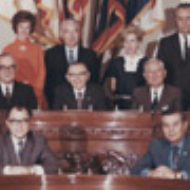Committee History
Historical Highlight
 The House Committee Drafting Articles of Impeachment, on Thursday, Feb.
27, in the Committee Room, House of Representatives, Washington, D.C., Collection of the U.S. House of Representatives
The House Committee Drafting Articles of Impeachment, on Thursday, Feb.
27, in the Committee Room, House of Representatives, Washington, D.C., Collection of the U.S. House of RepresentativesAbout this object
 The Judiciary Committee of the House of Representatives Receiving a Deputation of Female Suffragists, Collection of the U.S. House of Representatives
The Judiciary Committee of the House of Representatives Receiving a Deputation of Female Suffragists, Collection of the U.S. House of RepresentativesAbout this object
- Standard reference volumes about committees of Congress
- General works on the origins and development of the committee system
- Bibliographic references for standing and joint committees, arranged alphabetically with corresponding histories and studies
Footnotes
1Woodrow Wilson, Congressional Government: A Study in American Politics, reprint edition. (Cleveland, OH: Meridian Books, 1956): 82.
2Judy Schneider, “Committee of the Whole: An Introduction.” Washington, D.C.: Congressional Research Service, Library of Congress, 2007. Referred to as “The Committee of the Whole House on the State of the Union,” the Committee of the Whole signifies that House of Representatives will operate as a committee in order to process legislation in a speedier manner. During the nineteenth century, legislative deliberations shifted from the Committee of the Whole to standing committees. Currently, the Committee of the Whole operates as a forum to foster debate between Members, offer recommendations to the full House, and expedite passage of legislation by the full House. A quorum of the Committee of the Whole is 100 members.













